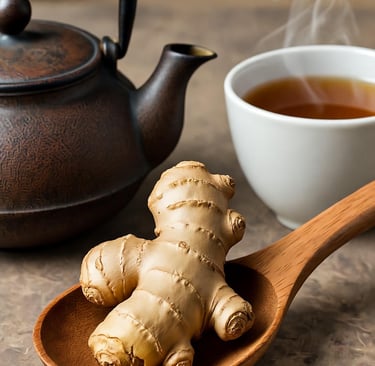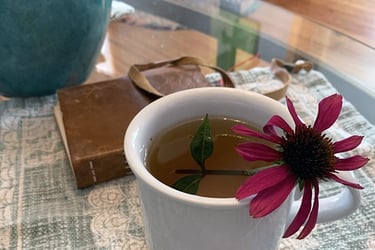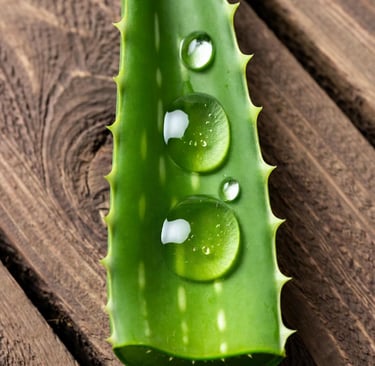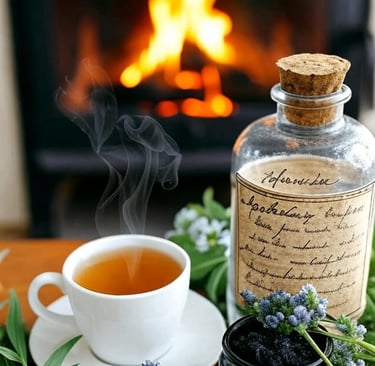Cozy Natural Healing: Top 10 Traditional Home Remedies for Fall and Winter Ailments
As autumn leaves fall and winter's chill settles in, these traditional home remedies, now enhanced with black drawing salve for bruised or cracked ribs, harness nature’s gentle power to ease seasonal ailments like colds, flu, respiratory issues, skin irritations, and injuries. Using simple, accessible ingredients, these recipes support adults and children
RECIPESHOME REMEDIES
10/24/20258 min read


Cozy Natural Healing: Top 10 Traditional Home Remedies for Fall and Winter Ailments
Introduction
As autumn leaves fall and winter's chill settles in, these traditional home remedies, now enhanced with black drawing salve for bruised or cracked ribs, harness nature’s gentle power to ease seasonal ailments like colds, flu, respiratory issues, skin irritations, and injuries. Using simple, accessible ingredients, these recipes support adults and children through the colder months. Always consult a healthcare professional for serious conditions, especially rib injuries or for children, to ensure safe healing.
1. Ginger Tea for Cold, Flu, Fever, Poor Circulation, and Fatigue
This warming brew is a fall favorite for boosting energy and fighting off chills.
Step-by-Step Recipe:
Peel and slice 1-2 inches of fresh ginger root.
Boil 2 cups of water, add the ginger, and simmer for 10-15 minutes.
Strain, add 1 tsp honey and a squeeze of lemon for taste.
Sip warm, up to 3 times a day.
Herbs Involved:
Ginger (Zingiber officinale): A spicy root with anti-inflammatory and antioxidant properties. It warms the body, improves circulation, and eases nausea or fatigue, ideal for fall/winter immune support.
Best Administration Methods: Tea (infusion) or added to soups. Oral intake is most effective.
Dosing: Adults: 1 cup (8 oz) 2-3 times daily. Children (over 2 years): 1/4-1/2 cup 1-2 times daily, diluted if needed. Start low for kids to avoid stomach upset.
2. Honey-Lemon Gargle for Sore Throat, Cough (from Cold, Flu, Bronchitis)
A soothing remedy for throats irritated by dry winter air.
Step-by-Step Recipe:
Mix 1 tbsp raw honey with juice from half a lemon in 1 cup warm water.
Stir until dissolved.
Gargle for 30 seconds or sip slowly.
Herbs Involved:
Honey: A natural antibacterial that coats the throat, reduces cough, and fights infections, perfect for fall respiratory issues.
Lemon: Citrus fruit rich in vitamin C, boosting immunity and cutting mucus.
Best Administration Methods: Gargle or tea. Topical for throat relief.
Dosing: Adults: 1-2 tbsp honey mix 3-4 times daily. Children (over 1 year, no honey under 1): 1 tsp mix 2-3 times daily.
3. Garlic Infusion for Cold, Flu, Bronchitis, Pneumonia, and Wound Infections
Nature's antibiotic for internal and external use.
Step-by-Step Recipe:
Crush 2-3 garlic cloves and let sit 10 minutes.
Add to 1 cup hot water or soup, steep 5 minutes.
Strain and drink, or use crushed as a poultice for wounds.
Herbs Involved:
Garlic (Allium sativum): Pungent bulb with allicin, an antimicrobial compound. It fights winter respiratory infections and speeds wound healing.
Best Administration Methods: Infusion, raw in food, or poultice. Oral for internal, topical for external.
Dosing: Adults: 1-2 cloves daily (raw or infused). Children: 1/2 clove or less, mixed in food, 1-2 times daily.
4. Echinacea Tea for Cold, Flu, and Immune Support Against Infections
Boosts defenses during flu season.
Step-by-Step Recipe:
Add 1 tsp dried echinacea root or leaves to 1 cup boiling water.
Steep covered for 10 minutes.
Strain and add honey if desired.
Herbs Involved:
Echinacea (Echinacea purpurea): Purple coneflower herb that stimulates immune cells, great for preventing or shortening fall colds and supporting wound healing.
Best Administration Methods: Tea or tincture. Oral for best results.
Dosing: Adults: 1 cup 3 times daily at first signs. Children: 1/4-1/2 cup 2 times daily.
5. Eucalyptus Steam for Bronchitis, Pneumonia, and Congestion
Clears airways in stuffy winter homes.
Step-by-Step Recipe:
Boil 2 cups water, add 5-10 drops eucalyptus oil or handful of leaves.
Pour into bowl, cover head with towel, inhale steam for 5-10 minutes.
Herbs Involved:
Eucalyptus (Eucalyptus globulus): Aromatic leaves with cineole for decongesting, easing breathing during winter respiratory peaks.
Best Administration Methods: Inhalation or chest rub. Not for ingestion.
Dosing: Adults: 1-2 sessions daily. Children (over 6): Supervised, 1 session daily, diluted.
6. Aloe Vera Gel for Skin Conditions, Wound Infections, and Poison Ivy
Soothes outdoor mishaps from fall hikes.
Step-by-Step Recipe:
Cut fresh aloe leaf, scoop out gel.
Apply directly to affected skin.
Let absorb, repeat 2-3 times daily.
Herbs Involved:
Aloe Vera: Succulent gel with anti-inflammatory compounds, hydrates dry winter skin, heals wounds, and calms poison ivy rashes.
Best Administration Methods: Topical gel. External only.
Dosing: Adults/Children: Apply as needed, thin layer.
7. Clove Oil Compress for Toothaches
Quick relief for dental discomfort in cold weather.
Step-by-Step Recipe:
Dilute 2-3 drops clove oil in 1 tsp carrier oil (like olive).
Soak cotton ball, apply to aching tooth for 10-15 minutes.
Herbs Involved:
Clove (Syzygium aromaticum): Bud with eugenol, a natural anesthetic, eases pain from winter dry mouth or infections.
Best Administration Methods: Topical oil. Avoid swallowing.
Dosing: Adults: 1-2 applications daily. Children: Consult doctor, very diluted if used.
8. Blackstrap Molasses Tea for Bruised or Cracked Ribs, Fatigue
A nutrient-rich tonic to support healing and energy.
Step-by-Step Recipe:
Stir 1-2 tsp blackstrap molasses into 1 cup warm water or herbal tea.
Add a splash of lemon juice (optional) for flavor.
Sip slowly, once daily.
Herbs Involved:
Blackstrap Molasses: Not an herb, but a mineral-dense byproduct of sugar refining, rich in calcium, magnesium, and iron. Supports bone and muscle repair for rib injuries and boosts energy during winter fatigue.
Best Administration Methods: Tea or mixed into warm drinks. Oral intake.
Dosing: Adults: 1-2 tsp daily. Children (over 2 years): 1/2 tsp daily, diluted. Consult a doctor for rib injuries in children.
9. Golden Milk for Bruised or Cracked Ribs, Inflammation
A creamy, anti-inflammatory drink to ease pain.
Step-by-Step Recipe:
Heat 1 cup milk (dairy or plant-based), add 1 tsp turmeric powder, a pinch of black pepper, and 1/2 tsp ginger powder.
Simmer 5 minutes, stir in 1 tsp honey (optional).
Drink warm, once daily.
Herbs Involved:
Turmeric (Curcuma longa): Root with curcumin, an anti-inflammatory compound that reduces swelling and pain from rib injuries. Black pepper enhances absorption. Ideal for fall/winter recovery.
Ginger: Adds warming, anti-inflammatory support.
Best Administration Methods: Drink or paste. Oral for systemic relief.
Dosing: Adults: 1 cup daily. Children (over 2 years): 1/2 cup daily, diluted if needed. Consult a doctor for rib injuries.
10. Comfrey Compress for Bruised or Cracked Ribs
A soothing topical remedy to reduce swelling and promote healing.
Step-by-Step Recipe:
Steep 2 tbsp dried comfrey leaves or root in 1 cup hot water for 10 minutes.
Soak a clean cloth in the cooled infusion, wring out excess liquid.
Apply to the rib area for 15-20 minutes, 2-3 times daily. Avoid open wounds.
Herbs Involved:
Comfrey (Symphytum officinale): A herb with allantoin, which promotes tissue repair and reduces inflammation. Ideal for external use on bruises or rib injuries from winter slips, but not for ingestion due to potential liver toxicity.
Best Administration Methods: Topical compress or salve. External only, not for broken skin.
Dosing: Adults: Apply 2-3 times daily. Children: Consult a doctor; use sparingly and diluted under supervision due to potency.
Additional Remedies for Bruised or Cracked Ribs
These extra remedies complement the above, offering more options to ease pain and support healing from rib injuries, which are common from falls on icy paths or winter activities.
11. Arnica Salve for Bruised or Cracked Ribs
Eases pain and swelling from injuries.
Step-by-Step Recipe:
Infuse 1/4 cup dried arnica flowers in 1/2 cup olive oil (warm gently for 1 hour).
Strain, mix with 2 tbsp melted beeswax to make a salve.
Apply a thin layer to the rib area, avoiding broken skin, 2-3 times daily.
Herbs Involved:
Arnica (Arnica montana): A flower that reduces swelling and pain, supporting recovery from fall/winter bruises or rib injuries.
Best Administration Methods: Topical salve. External only, not for open wounds.
Dosing: Adults: Apply thin layer 2-3 times daily. Children: Consult a doctor; use diluted under supervision.
12. Cabbage Leaf Wrap for Bruised or Cracked Ribs
A cooling, anti-inflammatory compress.
Step-by-Step Recipe:
Wash and slightly crush 2-3 fresh cabbage leaves to release juices.
Wrap leaves around the rib area, secure with a bandage or cloth.
Leave on for 20-30 minutes, 1-2 times daily.
Herbs Involved:
Cabbage (Brassica oleracea): Not an herb, but its leaves contain anti-inflammatory compounds like glucosinolates, reducing swelling and pain from rib injuries.
Best Administration Methods: Topical wrap. External only.
Dosing: Adults/Children: Apply 1-2 times daily. Safe for supervised use in children, but consult a doctor for rib injuries.
13. Willow Bark Tea for Bruised or Cracked Ribs, Pain
A natural pain reliever for injury discomfort.
Step-by-Step Recipe:
Simmer 1 tsp dried willow bark in 1 cup water for 15 minutes.
Strain, add honey if desired, and sip slowly.
Use once daily due to potency.
Herbs Involved:
Willow Bark (Salix alba): Contains salicin, a natural pain reliever similar to aspirin, effective for reducing rib injury pain and inflammation.
Best Administration Methods: Tea. Oral intake, but use cautiously due to aspirin-like effects.
Dosing: Adults: 1 cup daily, avoid if allergic to aspirin. Children: Not recommended; consult a doctor for alternatives.
14. Black Drawing Salve for Bruised or Cracked Ribs, Swelling, and Minor Skin Issues
A traditional topical salve to draw out impurities, reduce swelling, and promote healing in bruises.
Step-by-Step Recipe:
Prepare herb-infused oil: Combine 1 tbsp each dried comfrey, calendula, and plantain in 1/2 cup olive oil. Infuse for 3-4 weeks (shaking daily) or heat in a double boiler for 1 hour on low. Strain through cheesecloth.
In a double boiler, combine 3 tbsp infused olive oil, 3 tbsp coconut oil, 2 tbsp shea butter, and 2 tbsp beeswax. Heat until melted, stirring occasionally.
Remove from heat and stir in 1 tbsp raw honey until incorporated.
Add 1/3 cup activated charcoal powder, 1/3 cup bentonite or kaolin clay, and 20 drops lavender essential oil. Mix thoroughly.
Quickly pour into small glass jars or tins. Allow to cool and harden for several hours before use.
Herbs Involved:
Comfrey (Symphytum officinale): Promotes tissue repair and reduces inflammation, aiding bruise healing.
Calendula (Calendula officinalis): Anti-inflammatory and antimicrobial, soothes irritated skin from injuries.
Plantain (Plantago major): Has natural drawing properties to remove impurities and ease swelling.
Activated Charcoal: Adsorbs toxins and impurities, giving the salve its black color and drawing action.
Bentonite Clay (or Kaolin): Draws out toxins and bacteria, supporting wound and bruise recovery.
Lavender (Lavandula angustifolia): Soothes skin, reduces pain, and adds a pleasant scent.
Best Administration Methods: Topical salve. Apply to clean, intact skin over the bruised area and cover with a bandage. External use only; avoid open wounds.
Dosing: Adults: Apply a thin layer 2-3 times daily. Children: Consult a doctor before use; apply sparingly under supervision. Not a substitute for medical care—seek professional help for severe injuries.
Why These 10 Remedies (Plus Extras)? A Warm Explanation
These remedies, now including black drawing salve alongside comfrey, arnica, cabbage, and willow bark for rib injuries, are like cozy hugs from nature—simple, affordable, and rooted in generations of wisdom for fall and winter challenges. Black drawing salve, an old Amish favorite, uses charcoal and clay to gently draw out impurities and reduce swelling in bruises, while its herbs like comfrey speed tissue healing, making it a versatile addition for surface injuries from slips or strains. Blackstrap molasses delivers minerals to support bone and muscle repair, golden milk’s turmeric fights inflammation, and each remedy is gentle yet potent, empowering families to thrive naturally. They’re versatile for all seasons—aloe for summer burns, molasses for spring energy—making wellness a joyful, accessible journey all year round.
Conclusion
These remedies, with added options including black drawing salve for rib injuries, are your friendly companions for a healthier, more vibrant life through the seasons and beyond. Experiment mindfully, listen to your body, and consult a professional for rib injuries to ensure safe healing. Enjoy the empowering path of natural wellness!








